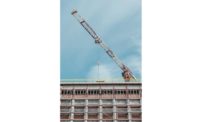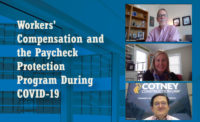This story was originally posted www.iccsafe.org/bsj, and was written by Karl Fippinger.
According to a recent International Code Council survey of U.S. code officials, 93 percent report their building and fire departments are still performing inspections, either remotely or in-person, during the COVID-19 outbreak. Engineering News-Record reports 47 of 50 states are allowing construction even with the vast majority of states having issued shelter in place or stay at home orders. The Centers for Medicare and Medicaid have issued blanket waivers for health care providers allowing non-hospital buildings and space to be used for patient care and quarantine sites, subject to state and local requirements.
Many communities are addressing the need for additional hospital beds and alternate care space by allowing the use of tents or temporary membrane structures. In some cases, communities are addressing the need for more beds by changing use and occupancy types for existing buildings. With these changes to our physical and built environment comes the need for code officials to rapidly institute enhanced health and safety measures in the field and in their office environments to protect themselves and those they work with. The International Code Council is helping code officials make these needed changes by offering guidelines, tools, and resources that can be used to develop policies and programs in their jurisdictions and communities of practice.
Classifying Exposure Risk
The Code Council recommends code officials take a risk-based approach to enhancing health and safety measures in their departments. The Occupational Safety and Health Administration (OSHA) published a document to help employers classify Worker Exposure Risk to COVID-19. The document divides job tasks into four risk exposure levels:
Very High Exposure Risk: Jobs with a high potential for exposure to known or suspected sources of COVID-19 during specific medical, postmortem, or laboratory procedures. Workers in this category include healthcare workers performing procedures on known or suspected COVID-19 patients.
High Exposure Risk: Jobs with high potential for exposure to known or suspected sources of COVID-19. Workers in this category include healthcare delivery and support staff, medical transport workers, mortuary workers.
Medium Exposure Risk: Medium exposure risk jobs include those that require frequent and/or close contact with (i.e., within 6 feet of) people who may be infected with severe acute respiratory syndrome coronavirus 2 (SARS-CoV-2), but who are not known or suspected COVID-19 patients. Workers in this category may have contact with the general public (e.g., schools, high-population-density work environments, some high-volume retail settings).
Lower Exposure Risk (Caution): Lower exposure risk (caution) jobs are those that do not require contact with people known to be, or suspected of being, infected with SARS-CoV-2 nor frequent close contact with (i.e., within 6 feet of) the general public.
While risk classification determinations rest with the Authority Having Jurisdiction (AHJ), the International Code Council offers the following practical examples and recommendations for classifying code administration tasks in the field, office, and remote work environments:
Field-Level Code Administration Activities
VERY HIGH or HIGH Risk: Code administration staff conducting field-level inspections for existing hospitals, laboratories, or mortuary facilities commensurate with OSHA guidelines.
MEDIUM Risk: Code administration staff conducting field-level inspections for new commercial or residential construction.
MEDIUM Risk: Code administration staff conducting field-level inspections for renovations of existing residential and non-hospital, laboratory, or mortuary commercial buildings.
Office-Based Code Administration Activities
MEDIUM Risk: Code administration activities including plan review, permitting, and other related activities.
Remote Telework or Work from Home-Based Code Administration Activities
LOWER Risk: Code administration activities including plan review, permitting, and other related activities that can be performed using remote telework or a work from home-based approach.
Cross-Contamination of Workspace Considerations
Further, the International Code Council recommends that code officials should consider the possibility of cross-contamination at the field-level to the office OR from the office to home as a planning factor when developing task level risk classifications. Additional consideration should also be given by code officials to any known “hot spots” or areas with high community transmission or infection rates that may drive the need to increase task-level exposure risk classification ratings.
Performing Job Hazard Analyses
To help minimize or eliminate risks, the International Code Council recommends code officials develop or update existing job hazard analyses for inspecting construction sites, temporary and permanent health care facilities, and existing buildings in the context of COVID-19 exposure risk. Most importantly, and sometimes overlooked, this should include changes to the way code officials conduct business and interact in their own offices and business environments.
OSHA offers a free, online Job Hazard Analysis booklet for employers, foremen, supervisors, and employees to help eliminate and prevent hazards in the workplace. Beyond identifying risk, job hazard analyses offer code officials the opportunity to implement a combination of controls to address or reduce risks from identified hazards.
Engineering Controls: Eliminate or minimize the hazard by design or use of substitute processes.
Administrative Controls: Written policies and procedures, training, limiting the time of exposure.
Personal Protective Equipment: When engineering and administrative controls are not enough to eliminate or minimize the hazard, the use of equipment such as respirators, safety glasses, and protective clothing are acceptable to help reduce risk.
Managing Risk in the Workplace
The International Code Council recommends code officials use a dual-pronged approach to risk management in the workplace that addresses both individual and workplace preventive measures for COVID-19.
Individual Preventive Measures
For all individuals, the Centers for Disease Control and Prevention (CDC) offers the latest information about COVID-19 and publishes individual guidance to help prevent the spread of COVID-19. The CDC guidance and recommendations for individuals includes:
- Know how COVID-19 spreads
- Clean your hands often
- Avoid close contact
- Cover your mouth and nose with a cloth face cover when around others
- Cover coughs and sneezes
- Clean and disinfect frequently touched surfaces daily
Workplace Preventive Measures
For workers and employers, the International Code Council recommends code officials refer to the OSHA COVID-19 webpage for specific workplace health and safety information. At minimum, code officials should review OSHA’s Guidance for Preparing Workplaces for COVID-19 document and use it as their definitive planning guide for workplace health and safety during the COVID-19 outbreak.
- Commensurate with OSHA’s COVID-19 workplace preparation guidance, the Code Council recommends code administration departments:
- Develop, publish, and conduct training on specific infectious disease prevention and control policies, procedures, and processes for COVID-19.
- Implement basic infection prevention and control measures from CDC and OSHA in the workplace as outlined above including the promotion of frequent and thorough hand washing.
- Develop department-specific policies and procedures to promptly identify and isolate sick workers, to include consideration of pre- and post-work health screening and reporting as needed.
- Consider the use of flexible worksites and work hours to increase physical distancing.
- Maintain or enhance housekeeping practices such as emptying trash and disinfecting surfaces, equipment, and other elements of the work environment.
- Implement workplace engineering controls such as the use of high-efficiency air filters, increasing ventilation rates in the work environment, or installing physical barriers such as clear plastic sneeze guards.
- Minimize contact among workers, customers, and others by replacing face-to-face meeting with virtual communications.
- Consider the selection, training, and use of personal protective equipment (PPE) based on job hazard analyses including gloves, face masks, safety glasses, face shields and other protective equipment.
For more information and additional resources visit the International Code Council’s Coronavirus Response Center.








